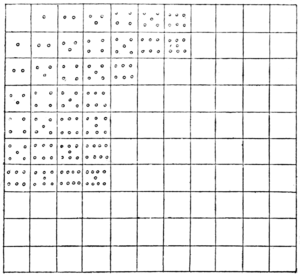 Image via Wikipedia In our last thrill-packed episode of Braintenance, we discussed the benefits of doing arithmetic calculations ("chain calculations") without the assistance of computers or any extrasensorial visual aids. The problem in the re-posting of the last show, yielded an answer of 28 [or at least it should have]. Most people's biggest challenges are not the arithmetic at all -- the challenges are 1) memorizing a string of data, and 2) recalling the string in "pieces" ("fractional recall") when going back to check or reaffirm our computations.
Image via Wikipedia In our last thrill-packed episode of Braintenance, we discussed the benefits of doing arithmetic calculations ("chain calculations") without the assistance of computers or any extrasensorial visual aids. The problem in the re-posting of the last show, yielded an answer of 28 [or at least it should have]. Most people's biggest challenges are not the arithmetic at all -- the challenges are 1) memorizing a string of data, and 2) recalling the string in "pieces" ("fractional recall") when going back to check or reaffirm our computations.One hint which might prove helpful is to visualize the entire string as if it were placed at the top of your mental blackboard for reference, and to do the individual calculations below. In this way, you can trick your mind into having a source of embedded reference to go back to. By doing this, you'll have less problems worrying about 'losing your place,' during the computational process. And as we brain-builders know, worrying is the seed of some nasty self-fulfilling prophesies.
Take a look at the last drill, and then, we'll continue with a new challenge...
---------------
When we utilize computers and other visual aids to do arithmetic calculations, several of our cognitive and computational abilities atrophy. We must exercise them in order to keep them strong. The simple process of doing arithmetic in your head allows you to visualize and to memorize. Many studies have shown that this rather simple exercise is one of the best ways to delay the onset of dementia and a number of other physiological manifestations of diminished mental capacity.
Do the following example in your head...no using fingers to draw in the air, or using of any other external physical processes (especially whispering the numbers to yourself0. I'll get you your answer tomorrow. Go ahead. Try this simple one [by the way, you'll actually find it confusing to look at the numbers on this page at the same time you visualize the computations in your head. With practice, this problem can be eliminated by simply taking a mental "photograph" of the numbers, closing your eyes and dedicating your mind to doing all of the work internally.
3 + 8 - 5 + 9 - 2 + 12 - 4 + 13 - 6 = ? ? = 28
---------------
Here's a new set of operations to work on in the same manner as you did on the previous set, except that now we will use multiplication and division. Never mind about your third-grade teacher's order of operations lecture....simply do the operation in the order indicated. I'll give you an answer to check your work within a day or two.
5 x 6 / 2 + 7 x 3 -5 = ?
Other things to think about:
1) Might these problems be easier/ more difficult if presented in a multi-row format, with a small number of operations per row? Why?
2) Might these problems be easier/ more difficult if presented in a vertical column instead of in a horizontal row? Why?
3) Please follow some of our Twitter postings. For a complete listing (-phew-), simply visit http://TwitterLinksHubspot.blogspot.com.
Douglas E. Castle for Braintenance
[http://aboutdouglascastle.blogspot.com]
[http://Braintenance.blogspot.com]

Tweet



No comments:
Post a Comment